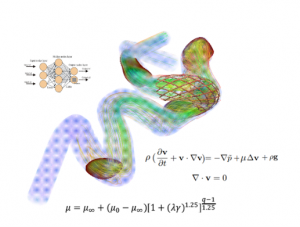Open PhD position: Fluid-Structure interaction of intracranial aneurysm: modeling, simulation and risk evaluation
CEMEF PhD thesis: Fluid-Structure interaction of intracranial aneurysm: modeling, simulation and risk evaluation.
Detailed presentation
Intracranial aneurysms are balloonings of blood vessels in the brain, thought to affect nearly 1 out of 30 adults worldwide. Most of these aneurysms never rupture, but those who do have disastrous consequences, as rupture is a major cause of subarachnoid hemorrhage, associated with severe morbidity and high mortality. The fatality rate is as high as 50% and about 30% of the patients who survive are permanently disabled, not to mention the significant economic burden on the patient and the healthcare system.
The PhD thesis aims at developing a high-fidelity numerical framework for accurate hemodynamics simulations able to handle strong fluid-structure interactions to encompass the mechanical exchanges between the blood flow, the patient-specific wall thickness, and more importantly the surrounding vessel tissue and the implanted endovascular treatment. The motivation behind pursuing such general approach comes from the desire to easily deal with several patients having a large diversity of aneurysm shapes, dimensions, and physical properties of tissue structure.
Until now, pure Computational Fluid Dynamics (CFD) modeling based on rigid wall assumption has been shown to overestimate the level of wall shear stresses and to disregard stresses in the wall tissue, which in turn may cast doubt in its ability to provide satisfactory criteria for rupture risk assessment.
Therefore, in this thesis, we will benefit from our advancement on providing dynamic remeshing for patient’s specific wall thickness interfaces and thus accurately encompassing the effect of solid. The proposed fluid (blood flow) – structure (aneurysm) solver can be seen as a generalization of the immersed volume method to FSI problems, that will allow dealing easily with a large diversity of shapes, dimensions, and physical structural properties. The fluid will be handled by solving the non-Newtonian Navier-Stokes equations coupled with nonlinear hyper elastic structure solver that should handle deformable vessel walls via tunable stress strain relations for nonlinear elastic material. Existing data (manufactured reference solutions and benchmarks) available from the literature will be simulated using very fine meshes for the comparison of different formulations. Then, several real patient data from our collaborator at LMU Hospital of Munich such as MRI images and 4D flow data will be used to develop the corresponding Deep Learning model for risk evaluation.

Expected profile
• Master of Science or equivalent in applied mathematics, physics, biology, or mechanical engineering, with competences in fluid dynamics, statistics, or scientific computing
• Good experience in programming (C, C++) and in data post-processing and analysis
• Excellent writing skills, fluent in English
• Rigorous, autonomous and motivated by working at the edge between basic research and industrial applications
General informations
- Industrial field: Numerical Mathematics, High Performance Computing and Data
- Location: Mines Paris - CEMEF, Sophia Antipolis
- Keywords: Fluid-Structure, Health, Biomechanics, Artificial intelligence, Simulation.
- Partners: LMU Hospital of Munich
- Duration: 3 years from October 2022
- Deadline for application: 30th of June 2022
CEMEF team
Computing and Fluids [CFL] research team under the supervision of Aurélien Larcher et Elie Hachem
To apply
- papers requiered to apply:
- your most recent CV
- Detailed, official proof of your grades during your most recent studies(maximum 3)
- One or more references from professors or heads of training programmes

